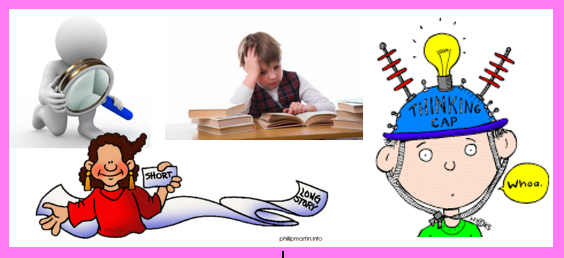
Chapter 1 in Daniels, Harvey. Subjects Matter: Exceeding Standards through Powerful Content-area Reading. Print.


Reading Skills in the Common Core Standards:
- Key Ideas and Details
- Recall and Infer
- citing textual evidence to support analysis of texts
- attending to precise details of explanations, descriptions
- draw inferences from text
- Summarize
- identify central ideas and conclusions in texts
- trace explanations of complex processes
- summarize how ideas (especially central) develop over a text
- Analyze
- analyze series of events, sequences of steps, series of arguments, etc.
- analyze cause and effect
- attending to special cases, exceptions, defined in texts
- sequencing and relating arguments in a text
- Recall and Infer
- Craft and Structure
- Acquire Academic Vocabulary
- determine meanings of vocabulary (key & related words and phrases), symbols,
- determining meanings of words in context, including their explicit and suggested meanings
- analyze cumulative effects of word and phrase choices
- Analyze Text Structure
- analyze how structure is used to emphasize key points
- analyze relationships among concepts
- analyze how idea and claims are developed
- Purpose and Point of View
- compare/contrasts points of view of different authors
- analyzing author’s purpose for selecting a specific research question
- analyze how author uses rhetoric to promote a point of view
- Acquire Academic Vocabulary
- Integration of Knowledge and Ideas
- Examine Text from Multiple Perspectives
- integrate quantitative or technical analysis with qualitative analysis
- translate technical texts into multiple representations such as equations, graphs, charts, etc
- analyze different genres and mediums, noticing what details some mediums include and leave out
- Evaluate Reasoning and Evidence
- evaluate to what extent evidence supports author’s claims
- identify false claims, false evidence, and specious lines of argument
- Compare and Contrast Texts
- compare various treatments of topics in primary and secondary sources
- compare and contrast findings from different research groups
- analyze seminal texts and how they address key themes and concepts
- Examine Text from Multiple Perspectives
- Range of Reading and Level of Text Complexity
- Read Deeply and Widely
- reading content specific texts that span grade appropriate lexile levels
- Read Deeply and Widely
Characteristics of More Successful Content-Area Reading Activities
- WHAT IS READ
- textbooks are not the sole sources of info
- subject matter includes relevant issues that affect the world and students’ lives
- read a variety of sources in order to make sense of what’s true and not
- read about settled and unsettled (debatable) ideas
- sample wide variety of genres – magazines, blogs, nonfiction books, other book genres, etc
- bias towards current information
- reading passages vary in length – short articles to book length
- many texts take interdisciplinary approach
- HOW IT IS READ
- not just to pass a test; to gather information, make meaning and apply knowledge of ideas to important issues
- teachers select some readings and students choose others
- not every student reads the same texts; strategies like jigsawing used to share information
- teachers scaffold thinking strategies that help students read more effectively
- learning activities deepen engagement with texts
- reading is seen as a social (not individual) activity
- instead of focusing on “right answers”, leave room for debate
- texts are connected by authentic themes; not isolated pieces of reading
- reading is linked to real world tasks such as research, documentation, correspondence and advocacy
- assessment to reading relied more on performance-based strategies, products and exhibitions

Teaching varied reading processes using engaging texts can help students develop better understandings of and more engagement with their courses. There is an equity gap in students’ reading levels that is correlated to their socioeconomic status. Using effective content-area reading strategies can help teachers support students in ways that narrow achievement gaps.

Preparation Steps
- Analyze past reading text selections and reading-specific learning activities. How do they stack up to the characteristics of effective content-area reading lessons?
- Research texts and strategies to fill in the gaps in your library and scaffolding activities. See above and Reading articles for ideas.
- Analyze skills needed to learn targeted standards and develop products in upcoming projects. Identify which of the reading skills listed above are critical to successfully learning targets standards and developing products.
- Write learning targets that relate to the reading skills students need to succeed in a project.
- Develop scaffolding activities that relate to reading learning targets
Early Implementation Steps
- Implement scaffolding activities that relate to academic and reading learning targets
- Use informal formative assessments to see if reading scaffolding is helping students to better learn
- Have students reflect on how reading strategies are impacting their learning
Advanced Implementation Steps
- Use series of student reflections and formative assessments to determine what reading strategies students are finding the most helpful. Incorporate most effective strategies into routines.

- Reading articles
- Literacy articles
- Learning targets